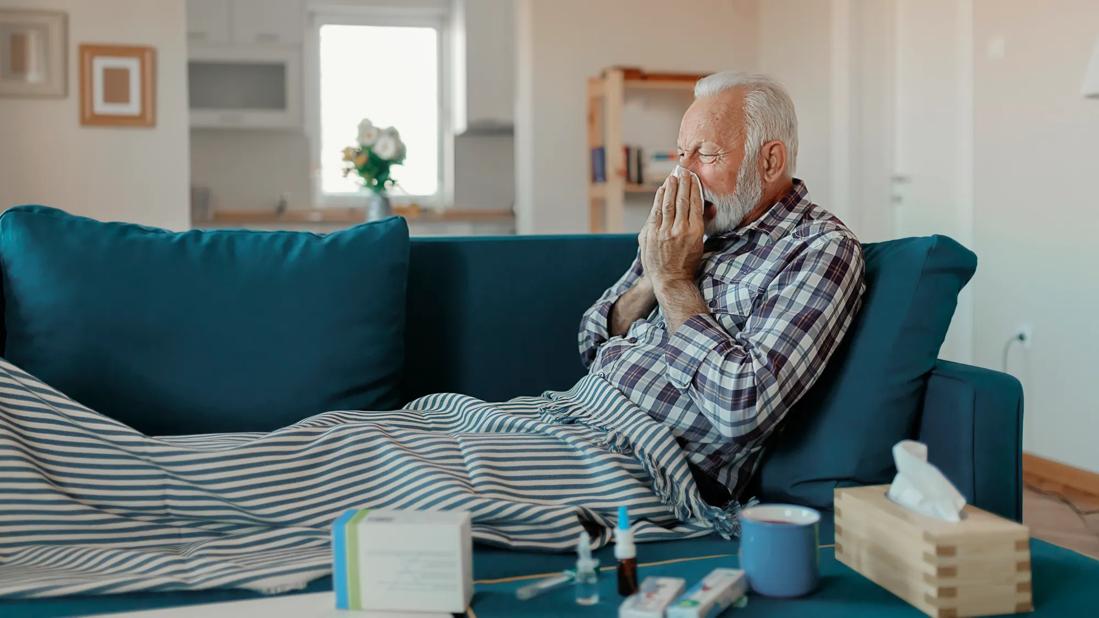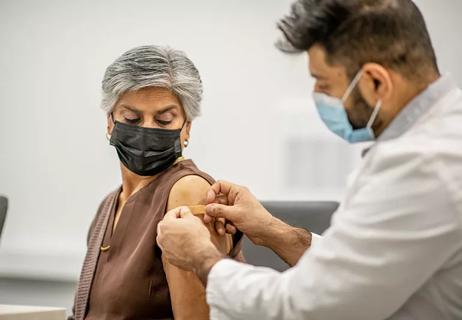Walking pneumonia is milder and doesn’t always require medication — but it’s also highly contagious

When you have cold-like symptoms, you probably slow down a bit, thinking you can beat it in a few days.
Advertisement
Cleveland Clinic is a non-profit academic medical center. Advertising on our site helps support our mission. We do not endorse non-Cleveland Clinic products or services. Policy
But what do you do when the symptoms linger or worsen? When they’re still not bad enough to knock you off your feet or anything, but bad enough that you can’t ignore them?
You may have walking pneumonia.
Walking pneumonia is also known as “atypical pneumonia” or “white lung pneumonia.” The most common cause of walking pneumonia is a bacteria called Mycoplasma pneumoniae, so your provider might use that name, too.
The condition strikes about 2 million people in the United States during an average year. But surges do occur periodically, usually during respiratory season. The U.S. Centers for Disease Control and Prevention (CDC) reported a particularly substantial increase in Mycoplasma pneumoniae, most notably in children, during the fall of 2024.
Walking pneumonia is frequently less severe than traditional pneumonia. In fact, it may be mild enough that you can be up and walking around, unaware of it. That’s how the condition got its name.
While walking pneumonia rarely leads to hospitalization, other forms of pneumonia are responsible for a significant proportion of hospital admissions in the U.S. They send about 1 million people to the hospital every year and cause about 50,000 deaths.
Advertisement
Walking pneumonia is usually less dangerous than pneumonia. But make no mistake: It can still leave you feeling lousy. And in some cases, serious illness can occur. The condition is also highly contagious.
Pulmonologist Neal Chaisson, MD, explains how you can end up with this common respiratory infection and how it differs from regular pneumonia.
The only way to know what kind of pneumonia you’re dealing with — or if you’re dealing with pneumonia at all — is to see a provider and be tested.
Some doctors will evaluate your symptoms, assume you have walking pneumonia and prescribe an antibiotic. But Dr. Chaisson doesn’t recommend that approach.
“The vast majority of patients with these symptoms have something viral, such as an upper respiratory infection, sinus infection or bronchitis,” he explains. Those illnesses are treated with time, rest and symptom-relieving medication. Not antibiotics.
Dr. Chaisson cautions that antibiotic overuse can lead to antibiotic resistance, allergic reactions or even Clostridium difficile, also known as C. diff. It’s an intestinal infection that causes diarrhea and abdominal pain. C. diff is difficult to treat and can cause life-threatening complications. The risk is particularly high for:
Antibiotics probably shouldn’t be the first step. But they may end up being the right step if your symptoms linger for more than a few days. Especially if you also have a chronic illness like emphysema, asthma, diabetes, kidney disease or heart disease.
Whatever type of pneumonia you have, your provider will probably diagnose you based on the results of a chest X-ray. They may also take blood or mucus samples, just to be safe.
People who have walking pneumonia usually start feeling unwell within two weeks of exposure. But it can sometimes take a month. That’s bad news because you’re contagious throughout that incubation period, even though you have no symptoms.
Once you do feel sick, it will take about four days for your symptoms to worsen. Typical complaints include:
Though the symptoms of bacterial pneumonia and viral pneumonia aren’t exactly the same, Dr. Chaisson says that both tend to cause shortness of breath and fatigue.
So, how do you differentiate between walking pneumonia and regular pneumonia? Because pneumonia is a more serious lung infection than walking pneumonia, the symptoms tend to be more extreme.
Advertisement
According to Dr. Chaisson, pneumonia causes your immune system to fill the air sacs in the lungs with mucus, pus and other fluids. That congestion makes it difficult for oxygen to reach your blood. As a result, you may experience symptoms related to poor oxygenation, like brain fog, a high heart rate and blue skin, lips or nails (cyanosis).
Pneumonia can be extremely serious, so don’t hesitate to call 911 or emergency services for acute symptoms like chest pain, difficulty breathing or confusion.
Walking pneumonia is often caused by bacteria or viruses. A bacteria called Mycoplasma pneumoniae is the primary offender.
While not all types of pneumonia are contagious, walking pneumonia usually is. Walking pneumonia spreads through respiratory droplets. In other words, you’re most likely to become infected when someone coughs or sneezes near you and doesn’t cover their mouth.
That’s why children and young adults are more likely to get walking pneumonia than the average person. The infection spreads easily in crowded environments like daycares, schools and college dormitories. Unfortunately, walking pneumonia hits assisted living facilities for the same reason, raising the infection risk for people over 65.
Advertisement
Unlike walking pneumonia, traditional pneumonia has a variety of causes. It can be bacterial or viral, yes. But in rare cases, you can also get pneumonia from fungi or protozoa.
Walking pneumonia may go away on its own. But antibiotics may be necessary if your symptoms are particularly bad or hang around for too long.
Dr. Chaisson adds that other types of pneumonia, on the other hand, usually require more medical attention.
“Regular pneumonia usually warrants antibiotics and sometimes, patients are hospitalized because they require oxygen, IV fluids and breathing treatments,” he continues.
“No matter what type of pneumonia you have ― whether walking pneumonia or a more serious form ― it’s important not to try to rush your recovery,” he stresses. “Don’t push yourself too hard. Expect that it will take a few weeks until you’re up and running at full speed again.”
Advertisement
Learn more about our editorial process.
Advertisement

Find out who needs protection the most

Diaphragmatic breathing, pursed lip breathing and huff coughing can help manage COPD symptoms, like chest congestion and shortness of breath

Changing how you breathe, gargling water and distracting yourself are all common ways to stop your diaphragm from spasming

If you have other cold and flu symptoms, it’s probably not strep

Options like fatty fish, citrus fruits and sunflower seeds can help keep you well and heal faster

From washing your hands and disinfecting surfaces to boosting your immune health, there are many ways to reduce your flu risk

Most can return to work or school when they’re symptom-free for 24 hours

Masking can help reduce the spread of respiratory illnesses in certain situations

The best parenting style balances enforcing rules and showing plenty of love

Tips include cutting back on sugar, focusing on exercise and managing stress

It can be harder to let go when you’ve invested time, energy and emotions — but it might be the healthier choice long term